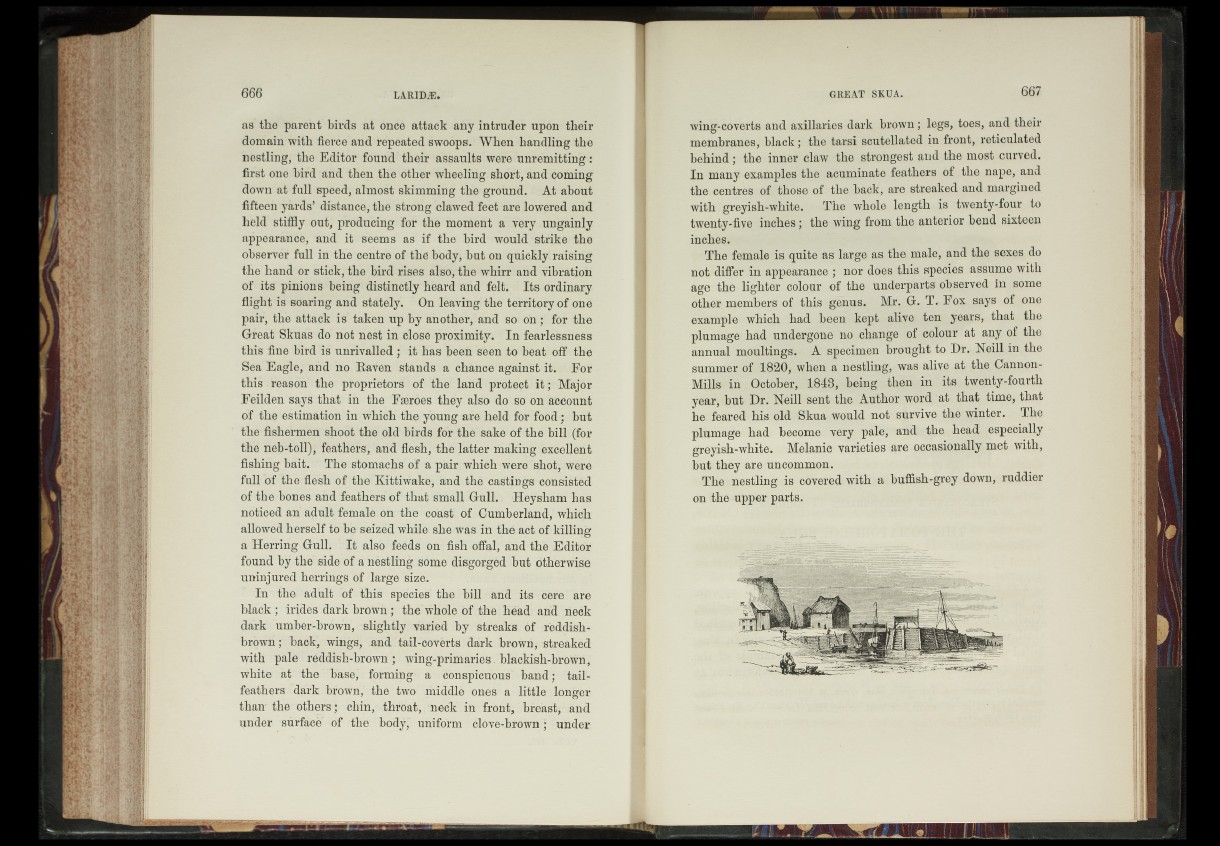
as the parent birds at óncè attack any intruder upon their
domain with fierce and repeated swoops. When handling the
nestling, the Editor found their assaults were unremitting:
first one bird and then the other wheeling short, and coming
down at full speed, almost skimming the ground. At about
fifteen yards’ distance, the strong clawed feet are lowered and
held stiffly out, producing for thé moment a very .ungainly
appearanoe, and it seems as if the bird would strike the
observer full in the centre of the body, but on quickly raising
the hand or stick, the bird rises also, the whirr and vibration
of its pinions being distinctly heard and felt;; Its ordinary
flight ’M soaring and stately. On leaving the territory of one
pair, the attack is taken up by another, and so bn;‘ for the
Great Skuas do not nest in close proximity. In fearlessness
this fine bird is unrivalled; it has been seen .to beat off .thé
Sea Eagle, and no Baven stands a chance against iter For
this .reason the proprietors of the land protect‘it!; Major
Feilden says that in the Faeroes they also do so on account
of the estimation in which the young are held for food; but
the fishermen shoot the old birds for the sake of the bill (for
the neb-toll); feathers, and flesh, the latter making excellent
fishing bait. The stomachs’of a pair which were 'shot, were
full of the flesh of the Kittiwako, and thé castings consisted
of the bones and feathers of that small ,’Gulk; Heysham has
noticed an’ adult femalè on the coast of Cumberland, which
allowed herself to be seized while she Wa s in thé act of killing
a Herring Gull; It also; feéds ön fish offal, and thé Editor
found by the’ side of a néstling sómo disgorged but otherwise
uninjured herrings of large size.
In the adult of this species’ the bill and its cere are
black; irides dark broWii; the1 whole Of the head: and neck
dark umber-brown, slightly varied by streaks Of reddish-
brown ; back, wings, and tail-coverts: dark brown, streaked
with pale reddish-brown ; wing-primaries. blackish-brown,
white at "tho base,’ forming- a 1; conspicuous’ band; tail-
feathers dark brown,!; the two middle ones a little longer
than the: others ; chin, throat, neck in front, bi-east; and
under surfacè" of the body,” uniform elove-brown; under
wing-coverts and axillaries dark brown; legs, toes, and their
membranes, black; the tarsi scutellated in front, reticulated
behind; the inner claw the strongest and the most curved,
In many examples the acuminate feathers of the nape, and
the centres of those of the back, are streaked and margined
with greyish-white. The whole length is twenty-four to
twenty-five inches; the wing from the anterior bend sixteen
inches.
The female is quite as large as the male, and the sexes do
not differ in appearance ; nor does this species assume with
age the lighter colour of the underparts observed in some
other members of this genus. Mr'. G. T. Fox says of one
example which had been kept alive- tern years, that the
plumage had undergone no change of colour at any of the
annual moultings. A-specimen brought to Dr, Heill in the
summer of 1820, when a nestling, was alj^g at the Cannon-
Mills in October, 1843, being then in- i ts twenty-fourth
year, but Dr. Neill sent the Author word at that time, that
he feared his old Skua would not survive the winter. The
plumage had become very pale, and the. head- „especially
greyish-white. Melanie varieties are occasionally met with,
but they are uncommon.
The nestling is covered with a buffish-grey down, ruddier
on the upper parts.